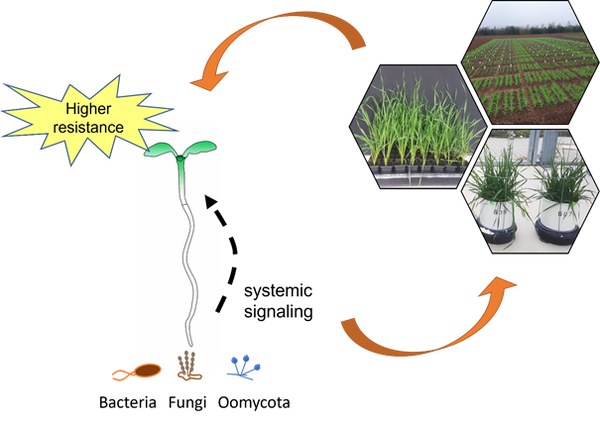Functional root ecology –plant fitness and resistance priming
Jennifer Thielmann
Collaborators: Gwendolin Wehner, Behnaz Soleimani (Julius Kühn Institute Quedlinburg, Germany), Johannes Schacht (Limagrain GmbH, Rosenthal, Germany), Mathias Wiegmann (RAGT 2n, Silstedt, Germany)
Background: Future cultivation of cereal crops will become more challenging due to more extreme weather conditions caused by climate change and occurrence of new pests and pathogens. In addition, access to effective chemical crop protection products is restricted while exploiting the genetic resources the plant for higher yielding and resistant varieties by classical breeding approaches is limited. Especially wheat (Triticum aestivum) as one of the most important crops worldwide plays a key role in food security and therefore it is crucial to identify alternative approaches for sustainable cultivation. Priming, a reaction in plants triggered by chemicals or microorganisms, manifests in higher resistance to diseases and pests as well as in an increase in biomass (yield) and might be a suitable approach. Besides well-known highly efficient priming-inducing microorganisms such as the endophytic fungus Serendipita indica and the bacterium Rhizobium radiobacter, native members of local soil microbiomes could be potentially employed to induce priming in crops.
Project: While phenotypical priming effects are already quite well investigated, we are just beginning to understand the genetic background as prerequisite for such priming responses. We screened a diversity set of 200 wheat genotypes for S. indica and R. radiobacter-induced priming responses regarding the parameters biomass and resistance to fungal diseases. Molecular genetics and GWAS (Genome-wide association study) analyses of the generated data will be used to elucidate the genetic basis of priming. A selected set of wheat genotypes is cultivated under semi-field conditions as well as in field experiments to observe priming effects under environmental stresses throughout growing seasons. Furthermore, we assess the technical applicability of cereal priming procedures. Our long-term aim is to establish priming capacity as a potential new breeding goal while offering approaches on how to employ priming in commercial large-scale cultivation systems.
Lab tools / techniques: Microbial cultivation and plant priming, infection assays, phenotyping, GWAS, metagenome and amplicon sequencing and analysis

Relevant publications:
Conrath U, Pieterse CMJ, Mauch-Mani B (2002) Priming in plant–pathogen interactions 7,5, 210-216
Glaeser SP, Imani J, Alabid I, Guo H, Kämpfer P, Hardt M, Blom J, Goesmann A, Rothballer M, Hartmann A, Kogel KH (2016) Non-pathogenic Rhizobium radiobacter F4 deploys plant beneficial activity independent of its host Piriformospora indica. ISME 10(4), 871-884.
Waller F, Achatz B, Baltruschat H, Fodor J, Becker K, Fischer M, Heier T, Hückelhoven R, Neumann C, Franken P, Kogel KH (2005) The endophytic fungus Piriformospora indica reprograms barley to salt stress tolerance, disease resistance and higher yield. Proc. Nat. Acad. Sci. USA 102, 13386-13391
Venneman J, Pawlick JS, Audenaert K, Meyerc E, Demeyere K, Leusd L, Baerte G, Kogel KH, Haesaert G, Vereecke D, Ehlers K (2020) Evaluation of genome size and quantitative features of the dolipore septum as taxonomic predictors for the Serendipita 'williamsii' species complex. Fungal Biology https://doi.org/10.1016/j.funbio.2020.06.001
